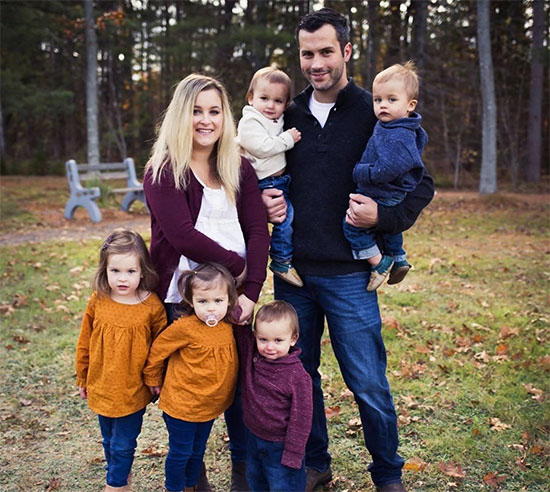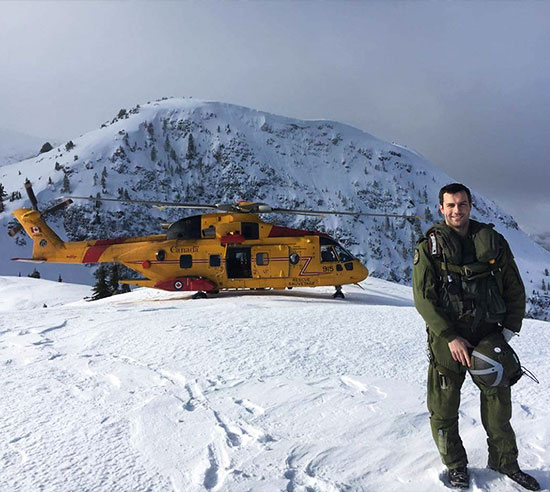Five kids under five: How this SAR spouse handles the unpredictable
May 7, 2021 - Defence Stories
By Holly Bridges

Caption
Kelly-Lynn Nicole, mom of five kids under five, including triplets
There are supermoms. And then there are military supermoms.
On any given day, Kelly-Lynn Nicole, mom of five kids under five, including triplets, never quite knows what to expect. One day her husband might be at home with the family or at work, while another he’s off flying potentially dangerous search and rescue missions, with little more than 30 minutes’ notice.
“A lot of people are amazed at how my spouse has to drop everything the minute he gets a call to go to a rescue. They are amazed at the missions he does,” says Kelly-Lynn, whose husband is is a flight engineer with 413 Transport and Rescue Squadron in 14 Wing Greenwood, N.S. “They can’t get over the fact that he could be gone for days for a mission with such short notice. At the drop of a hat, I’m left to hold down the fort.”
Short-fuse and unpredictability of missions
Such is life in search and rescue, one of the most unpredictable, and inherently dangerous, battle rhythms in the Canadian Armed Forces and the RCAF.
“Missions can happen at any given time. They happen in the middle of dinner, grocery shopping, family get-togethers, the middle of the night and most happen in bad weather and dangerous conditions. As a super woman as some may see me, I am only human and of course I can get extremely worried.”
A worrisome lifestyle
Kelly-Lynn, a “base brat” whose father served in the RCAF, says worrying is probably her biggest challenge. She and her husband lost friends in the 2006 crash of a CH-149 Cormorant in Nova Scotia, which often weighs heavily on her mind and heart.
“SAR isn’t exactly a walk in the park,” says Kelly-Lynn. “In better [weather] conditions, it could be a longer search mission with no telling when they will return. It’s hard to not have my other half home with me. We love our time together as a family. So, when the schedule changes and we have to change or reshuffle plans, it’s hard.”
How Kelly-Lynn copes
Kelly-Lynn credits a consistent, yet flexible, family routine with predictable nap times, “me time” with girlfriends (pre-pandemic) and “seize the moment” type of outings with her family during days off as ways of coping. Kelly-Lynn also has family in nearby PEI and New Brunswick to fall back on.
“Down time can also be a nice van ride in an afternoon when all the kids fall asleep. My husband and I will have a hot coffee or pit stop to local breweries or wineries to pick up a few treats for the evening.
“I do enjoy a hot shower, Netflix, snacks and a drink at home just fine. It won’t always be this way so we see this as a blessing and an adventure with plenty of time down the road with more time for us. For now, I’m happy to be needed.”
Needed indeed
The RCAF recognizes the immense sacrifices and contributions made by spouses like Kelly-Lynn, referring to them as “Invisible Crew Members,” without whose support the RCAF simply could not operate. Kelly-Lynn is proud to contribute in her own way to the RCAF mission.
“I don’t do an actual RCAF job but I am my husband’s biggest fan, study buddy, his rock and stability.
“Being a stay-at-home mom at the moment means he doesn’t need to worry when he gets a call. He can just go.”
Hubby says thank you

Caption
Kelly-Lynn’s husband, MCpl Dan Domonkos
Kelly-Lynn’s husband, MCpl Dan Domonkos, says a lot of people would be amazed at the sacrifices made by military spouses, and adds "she makes it so I don’t need to worry and I can focus on missions and my job."
“I would like to thank my beautiful wife for always being by my side and supporting me with everything! I couldn’t do this alone and appreciate everything [she] has done for me and our little family!”
Help for SAR spouses
Although Kelly-Lynn finds it hard to ask for help, she says it would be nice if others in the military community could know somehow when SAR spouses are alone, unlike Army and Navy spouses whose community support systems are fairly established during predictable and longer deployments.
“SAR spouses deal with instant, mini, local deployments. We don’t know when the call will come in; and when they leave we don’t know when they might return - and if they will. It would be nice for others to have a better understanding of our lifestyle.
“We need a community, a village, something to reassure SAR spouses there are people they can count on when they need help the most. Kindness, company and conversation. When our husbands are away or during the most stressful times, a simple tea and treats dropped off for the kids, a friend that pops by with a ready-made meal, to drop in and break up the day or help with bedtime routine would be great.”
Still, Kelly-Lynn wouldn’t change things for the world.
“It’s an adventure and we like to travel. I’ve grown up with this lifestyle, and I think it’s really what you make of it. It’s really the only life I’ve known, and it’s been a rewarding one thus far. I can pass down what I know of it to my children. They will have each other through moves, learn to adapt to new surroundings and keep an open mind to new possibilities. Plus, you make friends everywhere you go. It can really be a positive lifestyle.”
RCAF Family Connection Program can help
If you would like to find a friend or be a friendly connection during the Annual Posting Season, register for the RCAF Family Connection Program.
The RCAF Family Connection Program’s volunteer connectors stand ready to assist families settle into their new communities during the posting season, and to support families who are separated from their loved ones due to military service.
You can register here.
The Canadian Armed Forces and the RCAF have the main responsibility for providing SAR from the air in Canada. It also coordinates the national response for air and maritime SAR. CAF assets are tasked to respond to about 1,000 SAR missions every year with families holding down the fort for almost every one. We celebrate and thank them for their service.